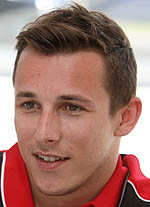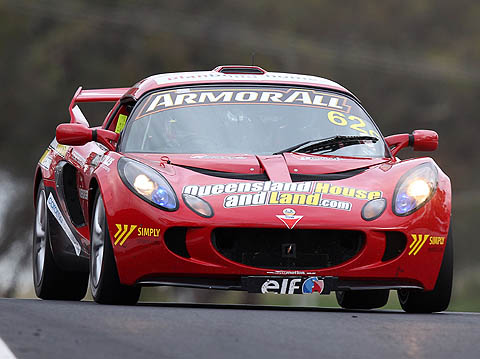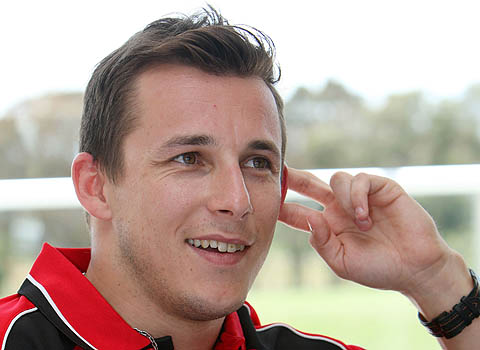


04/04/2012
FEATURE BY MAT COCH
 It rises and falls like an empire at war, scaling the side of a mountain before ducking and diving through trees as it hastily advances down the far side. Every year an army descends upon it, laying siege to the countryside for a weekend while around them war is waged.
It rises and falls like an empire at war, scaling the side of a mountain before ducking and diving through trees as it hastily advances down the far side. Every year an army descends upon it, laying siege to the countryside for a weekend while around them war is waged.
To most Australian motor sport fans Bathurst is Mecca, a place of spiritual enlightenment often experienced through the bottom of a beer bottle. It's one of the world's greatest circuits, so when the opportunity arose Christian Klien heeded the call to arms.
The Austrian has driven most of the world's great circuits in some of the most mouth-watering machinery on the planet. He's raced at Spa-Francorchamps in Formula One and won there in a Peugeot LMP1 sports car, but Bathurst poses a unique set of challenges.
"Spa is good in a Formula One car because it has very fast corners, very open corners," he says. "In a normal road car, like the Lotus, it would probably be really boring if you're used to racing at Spa in much faster cars. Blanchimont would be probably 160 km/h in the Lotus Exige, whilst in an F1 car we did it flat out at 290 km/h."
Bathurst suits GT cars, like the Lotus Exige Klien had been driving earlier. The narrow and steep circuit is a challenge, not like Spa which the Austrian promises is rather dull in anything much slower than a Formula One car, or an LMP1 car at a pinch.
Bathurst is Australia's own Spa-Francorchamps. It's no Nordschlieffe, but then at 20km long the Green Hell is just a bit silly, really. "This is more like… let's say a normal race track," agrees Klien. "You come around the same corner every two minutes, so it's more like a normal race circuit where the Nurburgring is so long, with so many corners." 154 of them to be exact - about one every 130 metres, but who's counting?
He laughs a lot. Relaxed, and happy, it's refreshing to see and was distinctly missing when we last spoke in Singapore 2010. Back then he was on the Hispania payroll as test and development driver, though in truth had done little other than drink espresso in the team's hospitality suite.
Hispania Racing Team was an experience, to say the least. The team had a relaxed attitude to routine maintenance (even brake pads weren't changed as often as you'd think) while pre-race preparations meant little more than dusting the car off after taking it out of the container.
He got the job at Hispania because of Colin Kolles, the pair having known each other since the days when Klien was a constant race winner in junior formulae before crossing paths again in Formula One. "He was actually running the team and solving all the problems. He did really an amazing job, but it just didn't have the budget."
Klien, veteran of more than 50 Grands Prix, was supposed to be the experienced figure in an inexperienced team. "They had Geoff Willis and he did some work in the background but his hands were tied because there was no money around," explains Klien. "By the end of the year I got a chance to do some races because the other drivers said they'd bring a lot of money, but they didn't." It was typical of the Spanish team, switching drivers as pocket books ran dry.
For Klien it harked back to his time as test driver at Honda when he was invited to audition with Force India, then known as Spyker. "They were not happy with one of their drivers so they asked me to test at Spa in the middle of the season," he recalls. Klien made an impression on Colin Kolles, who was managing the team, which would open doors later. However a racing return at that point was thwarted when Christijan Albers found the money to allow him to finish the season.
Pay drivers are now part of Formula One's staple diet in the way tobacco advertising once was; a driver's talent is linked to their bank manager's recommendation. "It's very frustrating," Klien admits. "For 2011 I was talking to a few teams, but everywhere you had to bring around $5million for a race drive. These days it is not enough to just be competitive; a driver is also required to provide sponsorship."
Klien has never had money; he didn't need it with Red Bull picking up the tab. He was one of the Austrian company's original three development drivers, and the first to reach Formula One. He was also the first to be put to the sword once the drinks company took over from Jaguar in the sort of shrewd move it has now become famous for. He could be bitter about it, and possibly is - he refuses to speak about his relationship with Dr Helmut Marko - but he's still thankful for the opportunities he had. "We didn't have the money to do motor sport so basically Red Bull paid for everything - all the lower categories until Formula One. That's very good, very positive," he admits.
 |
"They did all the very good work but once you get to Formula One they're changing drivers quite quickly." He spits the words like an overcooked steak as the smile which had been glued to his face suddenly disappears, replaced by a heavy frown. "So many Red Bull junior drivers have lost a drive. I think the talent and pace was there but other political aspects make them change the drivers - like you've seen now, again, with Buemi and Alguersuari. They told them in December, so there's no way to get another drive, which is not fair from my point of view."
The frustration in Klien's voice is obvious; like the Toro Rosso pair he'd burst on to the scenes as a 20-year old with Jaguar before being tossed on the scrap heap before his career ever really got going. Expectations within the Red Bull programme are high, unrealistically so Klien suggests. "I needed to be a frontrunner all the time in the junior categories," he explains. Winning races and championships Klien ticked all the boxes, though ultimately fell short of Red Bull's lofty expectations. Not every driver is going to be Sebastian Vettel - most aren't - but the programme suggests that the German Wunderkid is Dr Marko's benchmark.
Klien's jaw drops when I tell him his first Grand Prix, Australia 2004, was just his 102nd ever race start. "I was probably too young," he admits sheepishly. "On the other hand I had a very good year in Formula 3, and when you get an opening in Formula One you have to take it. If you do another year in Formula 3 or go to F3000 - which wasn't that good at that time - maybe you miss a chance to get to Formula One. When you get the opportunity you have to grab it.
"In my third Formula One race I managed to out qualify (Mark) Webber in Bahrain. It was a brand new circuit none of the drivers had experienced before," he remembers. "The first year was a steep learning curve.
"I felt the year after when I was at Red Bull - after Red Bull bought Jaguar - it was a lot easier for me and right from the beginning of the season I was there; I qualified in P6 or P7 in the Australian Grand Prix."
At the end of the 2004 season Jaguar was put up for sale. Ford had grown tired of its investment and was looking to exit the sport as quickly and easily as possible. Uncertainty over the outfit's future abounded before Red Bull became its knight in blue and silver armour, the drinks company giving the team a new set of wings, and more importantly a budget.
It also reintroduced the Formula One public to Dr Helmut Marko. "He's in charge of the Red Bull junior programme, so he's bringing drivers in," Klien explains. "The day to day business is of course Christian Horner at Red Bull Racing, but he (Marko) has an influence as well."
 |
Marko had a handful of unimpressive Grands Prix in the early 1970s though the Austrian did have some success at Le Mans winning the race in 1971. His racing career ended when struck by a stone thrown up by Emerson Fittipaldi's Lotus during the 1972 French Grand prix pierced his visor and hit him in his left eye, and so he moved into driver management thereafter. He joined Red Bull in 1999.
Alongside Klien at the rebranded Jaguar team in 2005 were the experienced David Coulthard and F1 newcomer Vitantonio Liuzzi. With three drivers and two cars it was decided the two youngsters would have to share. "That was Dr Marko," says Klien, "telling us that we have to share the seat. I've never seen that in the history of Formula One that you have to share a car, especially as a young driver where you need as many races, as many laps underneath your belts. You need the commitment of the whole team and as many test and race laps as possible."
"That definitely hurt us… We also had to share the car in testing whereas David Coulthard, who was very experienced, could do all the tests himself," he continues. "I did not know the car and tyres in the same way as him. Even still I managed to keep up in the first three races of the season, earning similar points. But after three races I was out of the race seat for another four races, and the US Grand Prix we did not start."
Klien solidified his position with Red Bull in what would turn out to be his best year in Formula One, faring better than teammate Liuzzi. "In the beginning he (Marko) said we'd share the whole season, 50:50. But then I started off very well, the first three races I was always in the points - I was actually ahead of Coulthard! Then I had to hand over the car to Liuzzi at Imola. He scored a point there, in P8, but then the next two or three races weren't that good, so then they decided that I was going to continue for the rest of the season."
By contrast the 2006 season started poorly for the team, and never really improved while Klien's relationship with Red Bull Racing began to deteriorate. "It was the first time Red Bull did their own car, and the car was absolutely not reliable," he recalls. "We had our first test at Silverstone and we could only do five laps in a row, then the car was overheating. It was 7 degrees outside! Probably they miscalculated the airflow through the radiators, with having the new Ferrari engine.
"Then the first ten races I had I think eight times where I didn't finish just because of technical problems, so it wasn't a good season."
The death knell came in Hungary when the team confirmed he was out of the job for 2007. "They did a Renault (engine) deal, and with the deal, managed by Flavio Briatore, came Mark Webber...
"Mark came up to me in a very fair way and said 'look, this is the thing'," he continues. "I knew by Hungary already that I was out of the car."
A lifeline was thrown by Red Bull with Klien offered the opportunity to race under its banner in Champ Cars. "I spoke with a few of the Champ Car team principals. Most of them stated that Champ Car is in trouble, and would probably collapse in a year or two years, so I saw no future there for me.
"I wanted to stay in Formula One, and that's actually why we split. At that time I saw the pace was there, it was good, so I said I wanted to stay in Formula One." It effectively signalled the end of his collaboration with the company that had supported him since he was 14. A year later Champ Car was gone, vindicating Klien's refusal of Red Bull's offer.
Soon after Klien's Red Bull wings were clipped, and he found himself dumped in favour of the Christian Horner managed Robert Doornbos for the final three races of the season.
With little hope of finding a race seat Klien became Honda's test driver. "At that time there was still a lot of testing, which was quite good," he says, though admits that Jenson Button - who went on to win the championship at the team two years later - always had the edge on him. "Normally he was two tenths faster than me in testing."
Button's fortunes, in going on to win the championship, contrast with those of Klien. Button's patience was rewarded where perhaps Klien jumped ship to the increasingly competitive BMW squad too soon. By then in-season testing had been banned, which meant long stretches out of the car, leaving Klien to look outside Formula One for racing opportunities.
"I wanted to race something else just to keep my racing abilities up. BMW allowed me to do a little sports car racing with Peugeot," he says. "I did four races; Sebring, Le Mans, Spa and Petit Le Mans." His results were good; third at Le Mans, fastest lap at the Petit Le Mans and victory in Spa.
However sports cars were only meant to be something to occupy himself with while he waited in line at BMW, his two year deal set to promote him to a race seat in 2010, "but then they pulled out!" Aside from his foray with HRT, Klien's Formula One career was effectively over.
He seems to harbour no ill-feelings or regrets - if our conversation is anything to go by, it could even be said he is grateful for it. "The best thing was when I went with Peugeot to sports cars in 2008. That opened my eyes and for the first time I had fun in motor sport again," he says, smiling at the thought. A stint with Aston Martin followed before things looked to be on the rise for the Austrian. "I was about to close the deal with Peugeot for 2012 and then they pulled out!"
The French team was in the process of deciding how to approach the 2012 season, and the newly created FIA World Endurance Championship, before the board decided to axe the programme. "The day before I was speaking to the team manager, and they had no clue that they were going to stop the whole programme."
Somehow, despite being without a drive at all for 2012 (although he tells me he's in talks with some teams), he keeps smiling and laughing. As we spoke about Formula One he was hunched over, fiddling with his iPhone nervously. Now, as we talk about the present and the future he's relaxed, leaning back in his seat and laughing as he speaks. He's a different man.
Like so many others he's glad to have left the political world of Formula One behind, and is revelling in the fact that he can now race what he wants, when he wants. "I could have a few more drives this year but it's just not in the category I like or not in the teams that I like," he smiles.
The races he has chosen are for a reason; racing at Bathurst was an opportunity to set himself up for a possible career in V8 Supercars, for example. "When I did the Indy race, the Gold Coast 600, everyone was talking about this track. So I said I definitely want to race here once," he explains. "It was perfect to learn the circuit, have a good time here... I was doing that because one eye is on going down to the V8 Supercars, which I really enjoyed."
V8 Supercars is Australia's premier motor racing category, more popular than Formula One. A mixture of endurance and sprint races litter a long calendar of events, which gets Klien particularly excited. "It's really good, close racing. You can overtake, the cars are almost the same so everyone has a fair chance," he enthuses. "I just love the way they run the race weekend. It's a bit like in America; it's very relaxed but at the same time very high level and very professional.
We wrap up as Klien heads back to the garage to prepare for qualifying. Driving a Lotus Exige around Bathurst is a long way from Spa and F1, but then Christian looks like a man who has come a long way too. The smile rarely leaves his face where it was once notably absent. As we part I asked him what his hopes are for the weekend, his response more chipper than ever. "Podium! There's only three cars," he laughs.
Note: Pictures courtesy of Nathan Wong at Speedshots
To check out previous features from Mat, click here